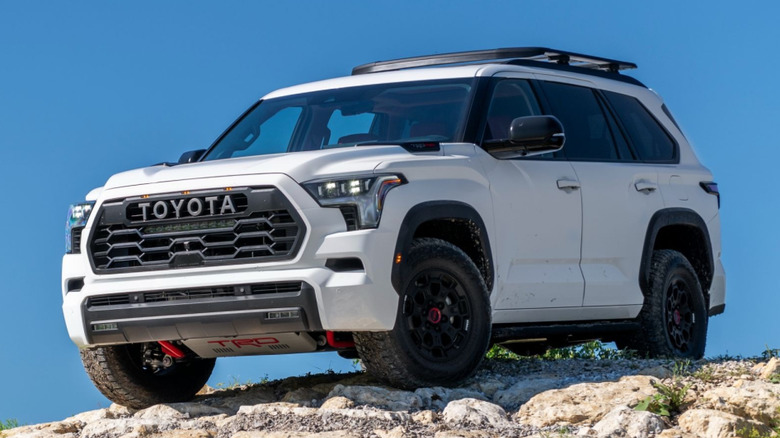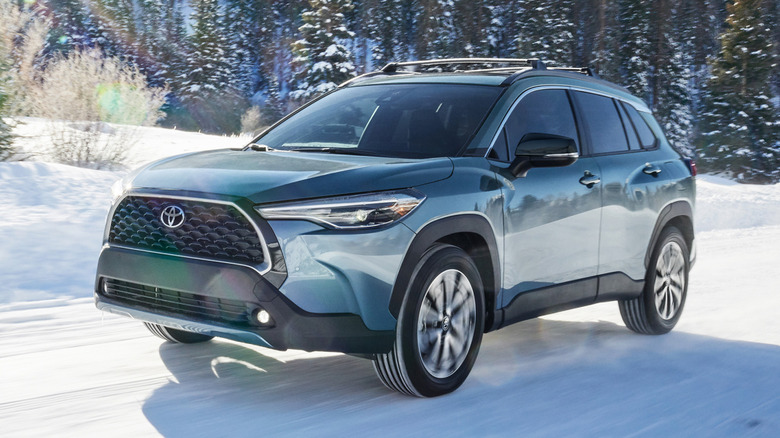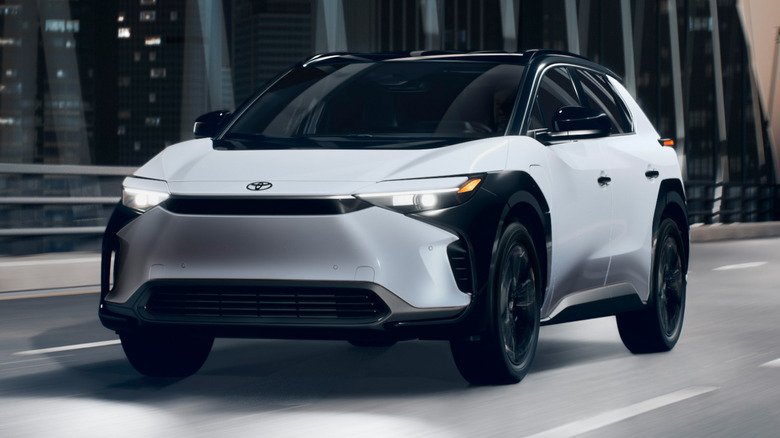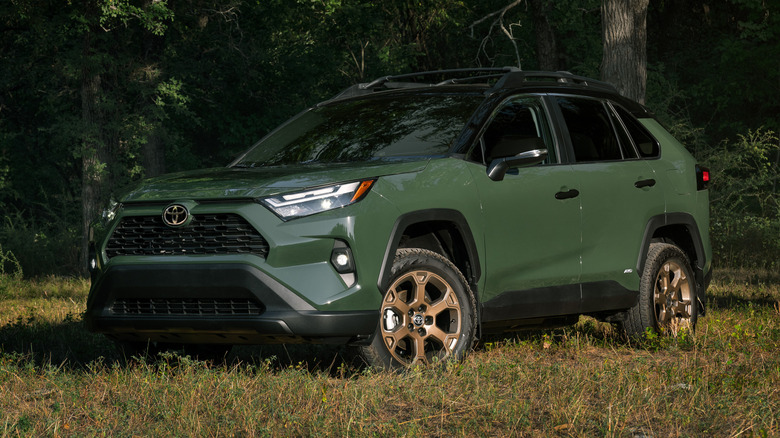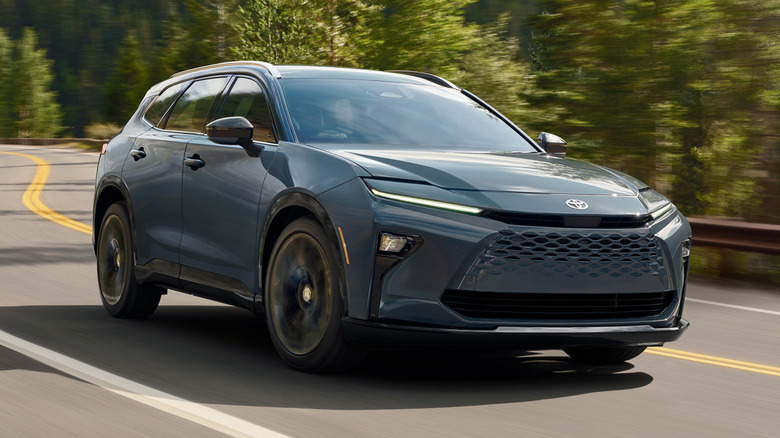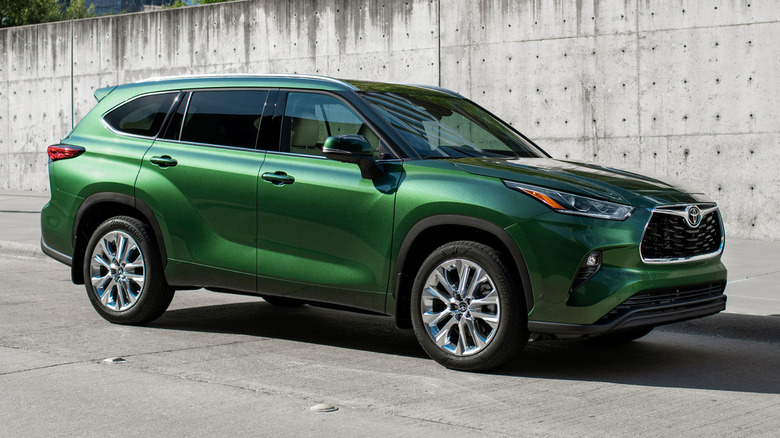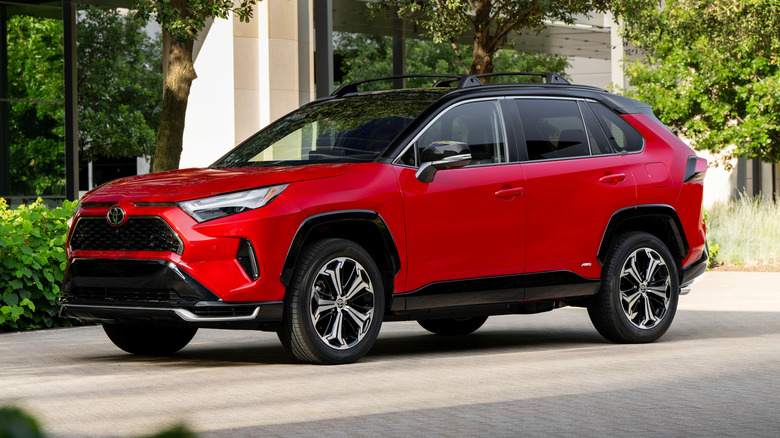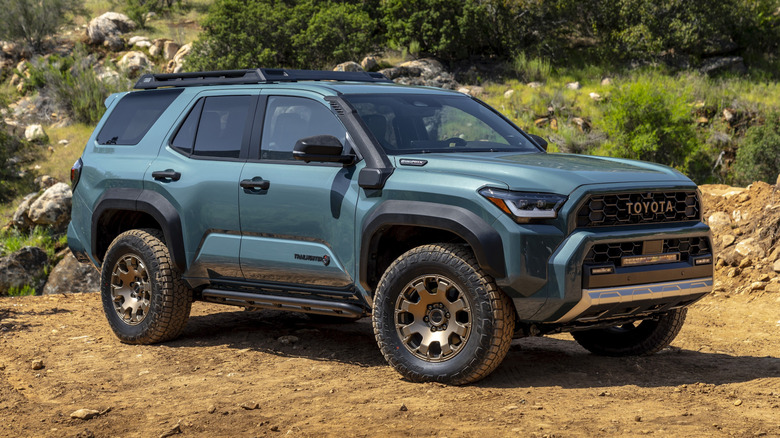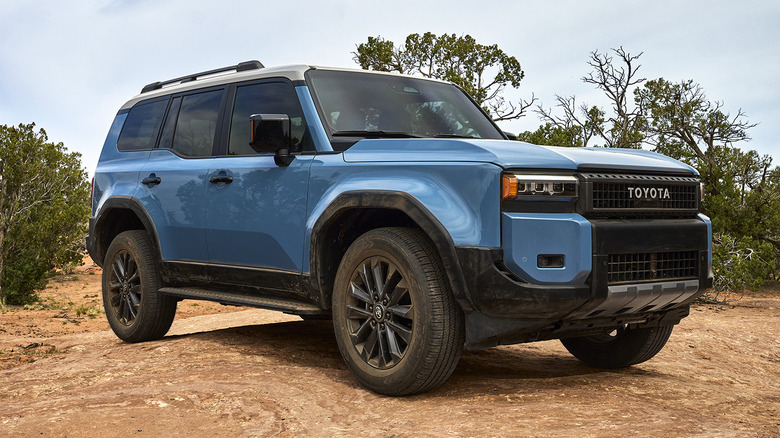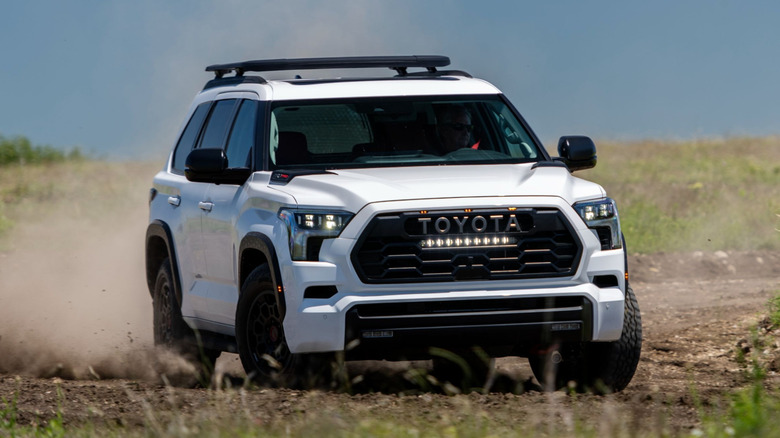10 Most Powerful Toyota SUVs, Ranked By Horsepower
Buyers looking for a powerful SUV face a dizzying array of options across the market, made more confusing by the wide array of powertrains on offer. From traditional gas engines, through hybrid and plug-in hybrid powertrains, to full EVs, there's a lot to unpick. Toyota offers all of these powertrains within its current SUV lineup, catering to almost all tastes and budgets. Some of its powertrains prioritize power and others prioritize efficiency, but for buyers looking for maximum horses under the hood, a few options stand out above the rest.
We've trawled through every powertrain on offer in the brand's current lineup to put together a list of the most powerful SUVs that Toyota sells in 2025, ranging from modest crossovers to full-size, all-conquering family haulers. We've ranked each model using the most powerful powertrain in its current lineup, but we've also compared those top powertrains to any other variants on offer within the same model to give you a more comprehensive overview of the brand's current powertrain range.
Toyota Corolla Cross Hybrid – 196 hp
As the smallest and cheapest SUV in Toyota's current lineup, it should be no surprise that the Corolla Cross Hybrid is also among the least powerful, with 196 hp on offer. The hybrid is available in a choice of four trims, from the entry-level Hybrid S to the top-spec Hybrid XSE. The power output of the car's 2.0L four-cylinder hybrid powertrain remains unchanged across all trims.
Alongside the hybrid version, a non-hybrid 2.0-liter four-cylinder powertrain is also available for 2025, and is rated for 169 hp. However, the hybrid is arguably the superior choice, as it's not only more powerful but also more efficient, meaning drivers should save money at the gas pump. The non-hybrid Corolla Cross is available with front-wheel drive as standard, with all-wheel drive optionally available. Meanwhile, all trims of the Corolla Cross Hybrid benefit from all-wheel drive as standard.
It might be the better choice in performance and efficiency terms, but the Corolla Cross Hybrid does have one drawback in that it's pricier than the non-hybrid. The cheapest non-hybrid trim starts from $24,135 excluding fees, while the cheapest hybrid will cost at least $28,495 excluding fees.
Toyota bZ4X – 214 hp
The most powerful EVs on the market boast horsepower outputs that would have been the preserve of sports cars just a decade or two ago, but Toyota decided not to enter the horsepower wars with its only current all-electric vehicle, the bZ4X. All trims of the electric SUV arrive with all-wheel drive and 214 hp, although range varies between trims. Three 2025 trims are available, with the mid-spec Nightshade trim offering the shortest range at 222 miles.
The top-spec Limited bumps that figure slightly to 236 miles, while the base-spec XLE can go the farthest on a charge, with 252 miles available according to Toyota's estimates. Those numbers are still modest compared to the best performing EVs on the market, but they should be plenty for drivers looking for an around-town grocery getter. Aside from its middling performance numbers, we found the bZ4X to be generally likeable, albeit with a few strange design choices in the cabin and styling that might put some buyers off.
Toyota RAV4 Hybrid – 219 hp
It's not as powerful as its plug-in hybrid counterpart, but the Toyota RAV4 Hybrid still posts respectable horsepower figures for a car in its segment and price bracket. Toyota rates the car's 2.5-liter hybrid powertrain at 219 combined horsepower, a modest improvement over the 203 hp on offer in the non-hybrid RAV4. The former is also slightly pricier, starting from $32,300 excluding fees.
Despite the modest performance jump in numerical terms, we found the hybrid to have noticeably more grunt on urban roads. All-wheel drive is also standard with the hybrid, although it's a different system to non-hybrid models. The latter uses a conventional all-wheel drive system, while electrified models rely on an electric motor at the rear for all-wheel traction. Non-hybrid RAV4s offer front-wheel drive as standard, with all-wheel drive available as an option.
The RAV4 won't be the first SUV in Toyota's lineup for buyers looking for the ultimate off-roader, but for anyone planning to take their car off the asphalt on a regular basis, the RAV4 Hybrid is offered in Woodland Edition trim. It receives TRD-tuned suspension, chunky Falken all-terrain tires, and all-weather cargo mats, alongside an AC power outlet in the rear for small appliances.
Toyota Crown Signia – 240 hp
The Crown nameplate is well known in Japan, but it's far from a household name in America. That hasn't stopped Toyota from bringing the Crown Signia SUV over to U.S. shores for 2025, as the counterpart to the sedan with which it shares a name. It's one of the brand's most upmarket models, nearing Lexus levels of luxury in some regards, particularly in top-spec Limited trim. Anyone looking for a lower-priced variant has precisely one other trim to choose from, the XLE. It starts from $43,790, while the Limited will cost at least $41,190.
All-wheel drive is available across both trims, and it's paired with a 2.5-liter four-cylinder hybrid powertrain that churns out a combined 240 hp. It's enough to make the Crown Signia hustle in town, but not enough to make it feel at all sporty. Much like most Lexus models, the Crown Signia is designed more for cruising than it is for performance.
Toyota Highlander – 265 hp
The current generation Highlander Hybrid has been on the market for several years now, and it seems that buyers aren't quite as keen on the model as they once were. U.S. sales data shows an almost 50% drop in Highlander sales in 2024 compared to 2023, but despite that drop in popularity, the SUV shouldn't be overlooked.
As well as offering three rows of seats and an upscale interior in top-spec Platinum trim, the Highlander Hybrid is also healthily equipped under the hood. However, it's the non-hybrid variant that has the edge in horsepower terms.
The 2.5L hybrid powertrain churns out 243 hp, and starts from $46,320 excluding fees for the XLE trim. However, The non-hybrid Highlander costs slightly less, starting from $39,820 in base-spec form, and offers 265 hp from its 2.4-liter four-cylinder engine. Much like the RAV4, all-wheel drive is optional with the non-hybrid Highlander, but standard on the Highlander Hybrid. The hybrid is the clear winner for efficiency, but going without electrification brings the most horses under the hood.
Toyota RAV4 Plug-In Hybrid – 302 hp
In some ways, plug-in hybrids offer the best of both worlds in the current ever-changing market. The best examples offer significant all-electric range, allowing drivers to do grocery runs or short suburban journeys without needing the gas engine. But, when it's time to hit the highway for longer trips, the gas engine's presence means that there's no need to rely on patchy public charging infrastructure.
That's the pitch of the RAV4 Plug-In Hybrid, which offers up to 42 miles of all-electric range. The added electrification also comes with another benefit: greater power. The RAV4 Plug-In Hybrid's combined 302 hp is a significant step up from the 219 hp available with the regular RAV4 Hybrid.
However, getting the most out of the plug-in powertrain will mean regularly taking it to a charger, and so buyers without access to a driveway or dedicated parking space might find that the regular RAV4 Hybrid is a better bet. Plus, there's the issue of cost, with the plug-in hybrid powertrain bumping the price of the RAV4 up significantly. The base SE trim starts from $44,265, while the more generously equipped XSE trim will cost at least $48,135.
Toyota 4Runner i-FORCE MAX – 326 hp
With a new generation launched for 2025, the 4Runner is no longer the traditional, aging off-roader of years past. Under its hood sits a choice of two powertrains, either an i-FORCE 2.4-liter four-cylinder engine or an i-FORCE MAX 2.4-liter hybrid powertrain. The hybrid is the more powerful of the pair, with 326 hp on offer, compared to the non-hybrid's 278 hp. Torque figures get a boost too, with the i-FORCE MAX billed as offering 465 lb-ft of torque while the i-FORCE develops 317 lb-ft.
The powertrains might be new, but fundamentally, the 4Runner hasn't changed so much in other aspects. It's still designed to be highly capable off-road, with multiple TRD-branded trims to pick from for buyers looking for maximum all-terrain chops. The $66,900 TRD Pro is the top off-road trim alongside the identically priced Trailhunter, while the TRD Off-Road and TRD Sport trims offer a TRD-lite experience for buyers looking to balance on-road and off-road capability. In base-spec form, the non-hybrid 4Runner starts from $40,770, but the cheapest hybrid is the TRD Off-Road i-FORCE MAX, which will set buyers back $51,990, excluding fees and options.
Toyota Land Cruiser i-FORCE MAX – 326 hp
Closely related to the latest 4Runner is the Land Cruiser, which shares both a platform and a powertrain with the former SUV. Its 326 hp output is identical to the 4Runner, although the Land Cruiser only offers the one hybrid powertrain, with no gas-only option available. We put a First Edition Land Cruiser through its paces at the launch of the current generation in 2024, but that trim is no longer offered for 2025. Instead, the only two trims buyers can pick from are the 1958 and confusingly named "Land Cruiser" trim.
To be clear, the top-spec version of the SUV is simply called the "Land Cruiser" and not the "Land Cruiser Land Cruiser," while the base-spec variant is called the "Land Cruiser 1958." The confusing naming seems to be taking a page out of Land Rover/Range Rover's playbook, and that's not the only area where the Toyota has taken inspiration from its British rival.
Its retro-modern styling, emphasis on upscale tech, and higher price point than before all put it closer in line to the latest Defender than its 4Runner twin, but Toyota is banking on the fact that buyers will be willing to pay more for the Land Cruiser nameplate. Whether that works remains to be seen, particularly since the 4Runner now offers identical underpinnings for a cheaper price.
Toyota Grand Highlander Hybrid MAX – 362 hp
Offering the interior space for a family but without the high price tag of the full-size Sequoia, the Grand Highlander was a new model in Toyota's lineup for 2024. It returns mostly unchanged for 2025 aside from the introduction of a new, base-level trim, the LE. With a non-hybrid 2.4-liter four-cylinder gas engine under the hood, the base-spec Highlander starts from $40,860 excluding fees, and offers 265 hp.
Buyers wanting more horses under the hood — or perhaps better fuel economy — should instead turn to the Grand Highlander Hybrid, which starts from $44,210. The standard hybrid powertrain offers only 245 hp, but in Hybrid MAX form, it delivers a combined 362 hp. Opting for the Hybrid MAX pushes the Grand Highlander's efficiency figures back down to roughly level with the gas powertrain, but it delivers plenty of extra kick and makes the SUV feel faster than its size might suggest. The Hybrid MAX is only available with the two priciest Grand Highlander trims, the Limited and Platinum, with the former costing at least $54,690 excluding fees.
Toyota Sequoia i-FORCE MAX – 437 hp
The most powerful SUV in Toyota's current range is the Sequoia, with its i-FORCE MAX powertrain churning out 437 hp. Despite sharing a name with the Land Cruiser and 4Runner's top powertrain, the Sequoia sports an entirely different setup under the hood. A V6 engine is assisted by electric motors, with its power sent to either the rear wheels or all four wheels thanks to the optional 4WD. Higher trims in the range receive 4WD at standard.
We found the 2025 Sequoia's go-anywhere capability to be a particular highlight, with the TRD Pro trim being the best way to maximize that capability. Likewise, the Capstone trim ticks all the right boxes for an upscale family hauler, although both trims are costly, starting from $80,295 and $83,915 respectively. Anyone on a tighter budget could consider the base-spec SR5 trim, which starts from $62,245. The Sequoia's lower trims are also marginally more efficient than their top-spec counterparts, but all share the same power output.
